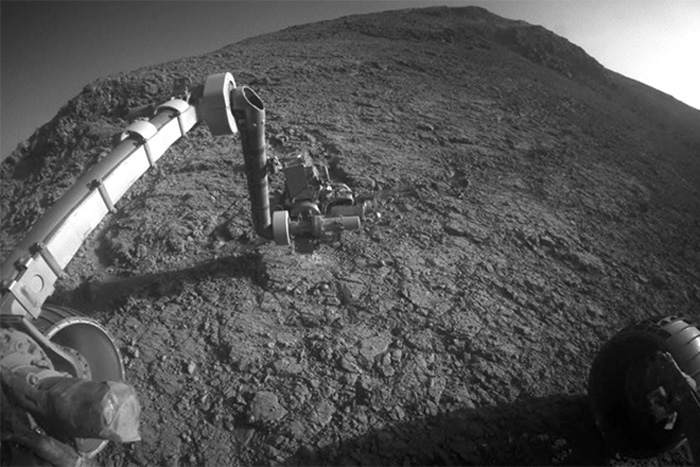Powered Up, Veteran Rover Soldiers Through Mars Winter

For a rover with a prime mission of only 3 months, NASA's Mars rover Opportunity sure is going above and beyond the call of duty.
On Monday, the veteran wheeled rover celebrated its 12th year (yes, that's 12 Earth years, or 144 months) on the red planet and, although it's been a hard road for the robot, it is still doing science. And it's doing science during the most aggressive period of the Martian year, which is nearly 687 Earth days long.
PHOTOS: 12 Years On Mars: Opportunity's First Sols
On Jan. 2, the southern hemisphere of Mars dipped into winter solstice, marking the shortest, and therefore darkest, day of Opportunity's year. For a solar powered rover, this is not a fun time. Opportunity requires sunlight to charge its batteries, so when daylight is limited, rover drivers need to position the rover at an optimized angle to collect as much of the limited sunlight as possible.
But with its crazy-extended mission comes some frustrating issues. Primarily, Mars dust collects on solar arrays, further limiting the mount of sunlight that can be used to charge batteries. Only recently, mission engineers were growing concerned by the viability of the rover's solar panels; they'd become so encrusted in years of dust buildup that solar energy had slowed to a trickle.
Then, Martian Mother Nature stepped in and provided Opportunity with a wonderfully timed and much needed "cleaning event." Cleaning events have become a critical, yet unplanned component of long-duration solar powered missions on the Martian surface. Opportunity and sister rover Spirit have both experienced Mars winds and dust devils that have blown over the rovers, removing some of the dusty layer, giving them a power boost. Opportunity's most recent cleaning event occurred toward the end of 2015, before it plunged into Martian winter, thus allowing the rover to continue its valuable work into 2016.
VIDEO: Drive With Opportunity on Epic Mars Rover Marathon
Get the Space.com Newsletter
Breaking space news, the latest updates on rocket launches, skywatching events and more!
"Opportunity has stayed very active this winter, in part because the solar arrays have been much cleaner than in the past few winters," said Mars Exploration Rover Project Manager John Callas, of NASA's Jet Propulsion Laboratory, Pasadena, Calif., in a NASA news update.
Since landing on Meridiani Planum on Jan. 24, 2004, Opportunity has provided some huge clues to Mars' ancient wet environment, the planet's unique geology and atmospheric dynamics. Having an unexpectedly long-duration rover on Mars has also taught NASA a thing or two about engineering and how to deal with aging robotics on a planet tens of millions of miles away.
The biggest age-related challenge currently isn't the rover's failing instrumentation or freezing wheel actuators, it's actually the rover's flash memory. Not designed for a multi-year mission, Opportunity's flash memory (akin to a computer's hard drive) is becoming worn out and NASA engineers have been working on strategies to bypass damaged memory banks, instead relying on the rover's on-board volatile memory (i.e. similar to a computer's RAM, which doesn't store data for long).
PHOTOS: 12 Years On Mars: Opportunity's Top 5 Revelations
Despite obvious limitations in what Opportunity can accomplish, valuable science is still being done. Most recently, the rover used its rock abrasion tool attached to its robotic arm to scrub a circle in the surface of a rock dubbed "Private John Potts" in "Marathon Valley," a location so-named for being Opportunity's "finishing line" when it completed just over 26 miles driven since landing in 2004. With the surface of the rock removed, other instruments on its robotic arm can be used to study its composition and therefore help geologists understand the conditions in which the rock was formed.
Marathon Valley is located in Endeavor Crater's rim, a crater the rover has been exploring since 2011. Orbital observations show the Valley has interesting clay deposits (formed when the Martian environment was a lot wetter than it is now) that Opportunity is investigating.
"With healthy power levels, we are looking forward to completing the work in Marathon Valley this year and continuing onward with Opportunity," Callas concluded.
It may be fighting age-related issues, but Opportunity certainly isn't done with Mars yet.
Originally published on Discovery News.
Join our Space Forums to keep talking space on the latest missions, night sky and more! And if you have a news tip, correction or comment, let us know at: community@space.com.
Ian O'Neill is a media relations specialist at NASA's Jet Propulsion Laboratory (JPL) in Southern California. Prior to joining JPL, he served as editor for the Astronomical Society of the Pacific‘s Mercury magazine and Mercury Online and contributed articles to a number of other publications, including Space.com, Space.com, Live Science, HISTORY.com, Scientific American. Ian holds a Ph.D in solar physics and a master's degree in planetary and space physics.









